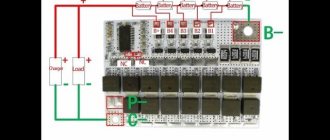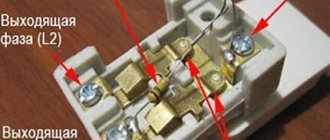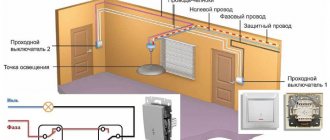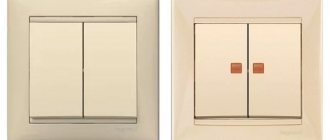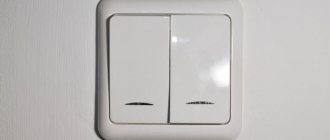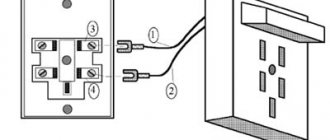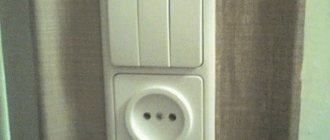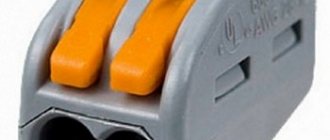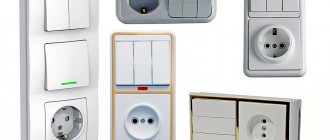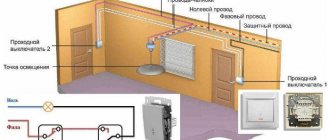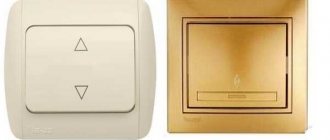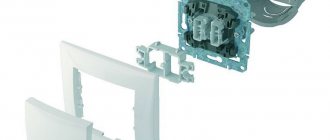To determine where the phase and neutral wires are located in the distribution box, you should first try to visually determine the identity of the wires by the markings. A cable is inserted into the socket box. Safety comes first.
The connection diagram for the three-key switch has been assembled. ✅Do-it-yourself three-key switch connection diagram
Well, that’s basically all I wanted to say.
It should be remembered that two-wire wires are connected to the lamps. If you look at the connection of the switch from the reverse side, you can see in the figure that four wires go to it.
When dismantling the old unit, remember, or better yet, label all the wires that you will disconnect. Three-key switch in everyday life Today, many people use a large number of lighting sources in their home.
Design of a three-key switch A large number of companies producing electrical equipment produce many models of switches. The room where repair work is carried out must be de-energized.
How to make a two-button/three-button switch from a single one
How does a switch with three keys work?
At first glance, the triple light switch looks like a regular light switch, but has three movable panels. This determines the dimensions of the device - in most cases it is slightly wider than its one- and two-key analogues.
Each controls its own group of contacts for on/off operation independently of the others. When manipulating a key, voltage is applied (and removed) to the dedicated load.
Internal diagram of the device.
If you remove the keys, the switch mechanism with 3 moving elements will open.
Triple switch with panels removed.
To install the switch at the installation site, you will need to remove the decorative plastic frame. Switches of other designs have a similar design - for example, three-button.
The device is ready for installation.
After this the following will be available:
- screws of expansion petals;
- terminals for connecting wires;
- holes for mounting the device on the surface.
It can be seen that the common contact of the device is at the top, but this is not always the case. This must be taken into account when preparing for installation.
Combined triple instruments
Switch with built-in socket
The triple switch, combined with a socket, is a combined version. It is suitable only for installation in certain places where it will be convenient to control the lamp and use the socket. The most suitable place for this is a dressing table in the bathroom, equipped if you need to connect a hairdryer or curling iron while simultaneously turning on the lighting.
You can install and connect such a module in its usual place – on the wall.
However, in this case the provisions of the current standards are violated. According to the PUE, the height of the switches must correspond to the level of a person’s forearm. The same requirements stipulate that the outlet should be located at a level of no more than one meter from the floor. The inconveniences of such an arrangement also include difficulties in including it in the existing wiring. To connect the combined device, you will need to modify the wiring diagram or run separate wires to it, which is not entirely aesthetically pleasing.
Area of application of the three-key player
The most obvious use of a 3-panel fixture is to control three lighting fixtures separately. Such a necessity in everyday life is rare. And in office or warehouse premises this is a very real situation.
But multi-arm chandeliers can be used in a house or apartment. Although they are real energy hogs (two 50-watt incandescent bulbs produce less luminous flux than one hundred-watt), such lighting devices are widely used for aesthetic reasons. The efficiency and comfort of operation of such lamps can be increased by using switches with several keys. By controlling not the chandelier as a whole, but individual lamps or groups of lamps, you can choose a convenient level of lighting and not waste electricity.
Kinds
You should not rush to connect a switch with three keys until you decide exactly what kind of device you want to have.
There are several types of such switching devices:
- Ordinary.
- Pass-through three-key switch. It is used on different floors or in long corridors, when at the entrance (on the first floor or at the beginning of the corridor) the lighting is turned on with one switch, and when leaving (on the second floor or at the end of the corridor) it is turned off with another. Its advantage is that you do not need to walk in the dark and crawl along the wall with your hand in search of the switching device button.
- With indication. Such light beacons have 2 options for indicating the state of the switch. Some glow when the lights are off and indicate the location of the switching device. Other beacons, on the contrary, light up when the lights are on, thereby making it clear where exactly the lights are on at that moment.
- Three-gang switch with socket. They are mainly used in rooms where there is a bathroom, toilet and corridor nearby.
Choosing an installation location
If we turn to the seventh edition of the Electrical Installation Rules, it turns out that there are no strict conditions for the installation of household switches. Clause 7.1.51 recommends installing switching devices at the entrance at a height of 1 meter from the handle side . The rules only determine the minimum distance to gas pipelines. It must be at least 50 cm. But there are two exceptions:
- in children's institutions, switches must be mounted at a height of 1.8 m - beyond the reach of children;
- It is prohibited to install switching equipment in wet rooms (baths, saunas, showers).
Otherwise, when choosing a place to install three-key devices, you can be guided by your own ideas about convenience and safety.
Connection options
The obvious connection diagram for any three-key switch is to control three different lamps. Each of the 3 contact groups switches its lamp independently of the others.
Control circuit for three lamps.
When connected via a junction box, the installation topology looks like this:
Laying of conductors to control three lamps.
The figure shows that to perform such installation you will need:
- three-core cable from the distribution board;
- three cables with three conductors to each consumer;
- four-wire cable from the distribution box to the switching device.
The junction box contains a large number of connections. Therefore, you need to choose a junction box of the appropriate size.
Important! The PE conductor may not be present in TN-C power supply systems. It does not affect the operation of the circuit. But if it is available, it must be laid and connected to the lamps to the terminals marked with the letters PE or a grounding symbol. This is a matter of operational safety.
In the absence of a protective conductor, the number of cores in the supply and outgoing cables is reduced by one. There will be a two-core cable going into the box and going out to each consumer, but in any case four conductors must be pulled to the switch.
Another option for connecting a device with three independent groups of contacts is to control multi-arm chandeliers.
Control circuit for a multi-arm chandelier.
The difference between this scheme and the previous one:
- conductors PE and N are drawn not to each individual lamp, but to the lamp as a whole;
- Each key can control either an individual lamp or a group of light bulbs, depending on the internal circuit of the chandelier.
Laying and connecting cables to control a multi-arm chandelier.
If you study the wiring diagram, it is obvious that in this case the installation in the junction box will be much less dense than in the previous case. The second difference is the list of cables. If the lighting is powered from a TN-S or TN-CS network (with a protective conductor PE), then for wiring you will need:
- 3-core cables from the switchboard to the box (two if there is no PE);
- five-core cable from the junction box to the chandelier.
As in the previous case, the switch is connected with a four-core cable.
The video clearly shows the connection diagram using an example.
Manufacturing companies
Often the choice of a particular switch with a socket is determined by the attractiveness of the design. For example, the Spanish company produces antique-style models. German products are distinguished by modern, sophisticated design. French electrics are successfully integrated into the surrounding interior: both vertical and horizontal modifications are made. Perhaps the widest selection of products is presented. The product line of this Swiss company also includes products with LED backlighting.
Among Russian manufacturers, Kuntsevo-Electro can be distinguished. The company produces several models of three-key switches:
- BELLA BKVR-039 (there is a socket without a grounding contact);
- BELLA BKVR-212 (with indicator light);
- BELLA BKVR-036 (the model is equipped with a European socket and protective curtains).
Combined unit Bella BKVR-033 and BKVR-054
The specified switches operate in 220 V networks with a rated current of 10 A. Models are also produced in Russia for a rated current of 16 A with grounding. For example, NPO Elektrotekhnika produces models BZVRzk-S and BZVRzksh-S.
What is required for installation
It will not be possible to carry out electrical installation without a minimum set of tools:
- To strip the insulation you will need a mechanic's knife;
- to shorten the conductors you will need wire cutters;
- to check the absence of voltage you will need an indicator screwdriver or a multimeter;
- for installation work - a set of screwdrivers.
If the connection in the junction box is made by twisting copper conductors, then it is advisable to solder the connection points. To do this you will need a soldering iron and consumables for it. Perhaps in the process of work the need for other tools will arise.
Preparatory work
Before starting installation, determine the location of the switches. If you plan to do hidden wiring, purchase built-in switches and socket boxes of appropriate sizes (plastic boxes in which the device will be installed). If the wiring is open, shims must be placed in the places where the devices are installed.
What tools and materials are needed
To connect a three-key switch you will need the following tools:
- electrical screwdriver with a flat slot, size 3.5–5 mm;
- pliers.
- knife or stripper for stripping insulation on wires;
Photo gallery: tools needed for work
Screwdriver leg isolated
Makes it easier for wires to be stripped of their insulation
Electrical installation pliers
If the switch is being installed for the first time, the consumables you will need are cables of the required cross-section, a junction box, an installation socket box, terminal blocks or insulating tape. For external wiring - a cable duct, and for hidden wiring - a corrugated sleeve and alabaster.
Photo gallery: necessary materials
Terminal blocks are used to connect conductors
Twist connections are insulated with electrical tape
Installation junction box
For external wiring, a cable channel is used
The switch is mounted in a socket box
The socket box is secured with alabaster
When purchasing a switch, you should pay attention to the “IP” code, which is usually printed on the packaging. The code consists of two numbers indicating the level of protection of the base from moisture and dust. This is especially important when installing the device in the bathroom or outside the house. The first number indicates the degree of protection from dust, the second - from moisture, on a 6-digit scale. For indoor spaces, IP 20 is sufficient; outdoors or in the bathroom it is better to install a switch with IP 66. In addition, a high-quality switch always has a connection diagram and a separate phase terminal (an arrow or the Latin letter L).
Connection diagram on the back of the switch
Selection of conductor cross-section
The cross-section of the cable cores depends on the load and installation method. Many years of experience show that a cross-section of 1.5 sq. mm in terms of throughput and mechanical strength is sufficient for 99+ percent of lighting tasks. This size has become a definite standard. The wide distribution of LED products only confirms this thesis - the loads in lighting networks do not increase. But if the case is non-standard, you can select a cable according to the table.
| Conductor cross-section, sq. mm | Allowable current, A | Permissible load at 220 V, W | ||
| Copper | Aluminum | Copper | Aluminum | |
| 1,5 | 19 | — | 4100 | — |
| 2,5 | 27 | 21 | 5900 | 4600 |
| 4 | 38 | 29 | 8300 | 6300 |
| 6 | 50 | 38 | 11000 | 8300 |
Although the rules allow the use of aluminum conductors, it is strongly recommended to use only copper products.
Next, you need to carry out the wiring - lay the cable products in accordance with the selected diagram between all the elements. It is better to use products with conductors numbered and marked by insulation color. If there is no such cable, you will have to perform conductor testing and core marking yourself. The cables should have a small margin of 10-15 cm in length. Upon completion of this work, you can begin the actual installation.
Safety requirements
When performing work, the main rule must be observed: all work is performed on de-energized equipment. If the wiring is being installed from scratch, then the connection to the switchboard should be done last.
If an existing lighting system is being reconstructed, to ensure safety it is necessary:
- turn off the corresponding circuit breaker in the switchboard, identifying it by diagram or marking;
- create a visible gap by disconnecting the wire from the terminal of the machine - this eliminates the erroneous supply of voltage;
- check the absence of voltage DIRECTLY AT THE WORK SITE.
The use of insulated hand tools contributes to increased safety. It is necessary to ensure that the insulation of the handles is not damaged or worn out.
Switch installation
Assembling the circuit can begin by installing the switch. The wires leading into the device's socket box must be shortened with wire cutters to a reasonable length so that the device can be put in place. Next, use a utility knife to remove the top sheath from the cable.
Cable with the sheath removed.
Then strip the insulation of the conductors with the same knife; if you have an insulation stripper, it will be more convenient to work. In the end it should look like this:
Socket box ready for installation of the device.
Next you need to look at which side the common terminal is located on. This determines what the on or off position of the switch will be.
Correct position of the key during installation.
In Russia, it is customary for the “off” state to be when the bottom edge of the key is pressed. This tradition comes from the requirement of the rules that the switching element cannot turn on under the influence of its own gravity. This applies, rather, to switches, but the principle is established. Another version is that the rule comes from the condition that in a critical situation a person should be able to turn off the tension by the gravity of his body. Either way, it's a force of habit. Some countries have adopted the exact opposite standard, and this does not affect the actual operation of the lighting system .
Therefore, you need to connect the switch so that controlling the light is convenient and familiar.
The moment of installation of the three-key player.
After this, you can install the device in the socket box, open the petals, fasten it to the wall with self-tapping screws and put the plastic decorative elements in place.
Tee assembly diagram.
Junction box installation
If a three-key switch is used to switch three independent consumers, each of which has its own cable, then the conductors in the box should be arranged as follows:
Installation of conductors for three lamps.
The connection of the cores should be made according to the diagram given above:
- connect the PE conductors (yellow-green) to each other;
- neutral conductors (in this case white, except for the one going to the switch) are also connected to each other;
- connect the red wire of the power cable to the red wire (so as not to get confused) going to the switch, this will be a common conductor;
- Connect the white, brown, yellow wires of the four-core cable with the corresponding red core of the cables going to the lamps.
Of course, the color of the cores does not affect the performance of the system, but maintaining the order of colors will minimize installation errors and facilitate possible repairs in the future.
If a three-key player controls individual lamps of a multi-arm chandelier, then the installation looks less cumbersome.
Installation of conductors for a multi-arm chandelier.
As in the previous case, the yellow-green (PE) and white (N) wires must be connected at the supply cable and the one going to the chandelier - they go through the box in transit. The red wires of the power cable and the one going to the switch are also connected. And the white, yellow and brown core can be connected to the cores of the same color of the outgoing five-core cable.
